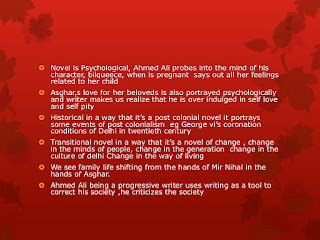Ahmad Ali’s Twilight in Delhi is a marvelous novel. It brings before our eyes a true “motion-picture” of how the Muslims of the sub-continent used to live their religious, social, cultural, single and collective life during the tumultuous years of 1857-1919. Another important thing to note is that, Ahmad Ali shows us all the positive as well as negative aspects of the Muslim Cultural life of sub-continent. So there is no taboo binding the hands of the writer to omit this or that part of the life: he presents life as a whole in all its aspects and colors. The details of Mehro’s marriage with Meraj, the son of Bhopal millionaire, added with the details of Mushtari Bai and Babban Jan, provide ample proof for our statements in this respect. We also find details of two pastimes that were very popular at those times among the gentlemen and others: pigeon-flying and kite-flying. There would be only a few such cities in the world which have become living landmark in the history or civilization of the world at large and of the related country in particular. Constantinople (now known as Istanbul) is one. Rome is another. Delhi is still another. Delhi can boast rightfully of a culture and civilization that has its long, deep roots going back into the 2nd century B.C. Built in 1453 B.C. by the name of Hastnapur by Raja Yudhishtra after the great battle of Mahabharat, Delhi had seen many ups and down in its long history. It has seen the age of Kauravs and the Pandaus. It has seen the rise and fall of the Khiljis. It has seen the regime of the Sayyeds. And lastly it has seen the supreme, superb and colorful reign of the great Moghals; Babur, Huamyun, Jahangir, Shah Jahan, the grand and great line culminating in Bahadur Shah (Zafar), the last of the Moghal dynasty who was overthrown by the Britiehers, or Farangis, as the people of the sub-continent including the Delhi-ites used to call them.
According to the novelist himself: “Destruction is in its foundations and blood is in its soil. IT has seen the fall of many a glorious kingdom and listened to the groans of birth. It is the symbol of life and Death …”
Ahmad Ali has seen the lanes, by-lanes and streets of Delhi with great affection. So Ahmad Ali has drawn a detailed picture of the life going on in these lanes and by-lanes during the last years of the 19th and the earlier years of the 20th century. The life is the true representation of the decaying Indian Muslim civilization during the period referred to above.
With this novel was published in 1940 by Hogarth Press, London, a lot of reviews appreciations about the same appeared not only in India but also in England. The novel gained spontaneous attention of the literary critics in India and abroad. One of the main aims of Ahmad Ali in writing this novel in English language was to acquaint the English-speaking world about the Indian civilization and its presentation through the life of novel’s characters.
In his essay entitled “Some Reflections on the Novel” Ahmad Ali himself writes: “The Novel is not an imitation but representation of life and its changing shadows, reflecting their movement and directing the changing scene of human activity in all ages and societies…. For the canvas of life is too vast and can be presented only in the moments of shattered desire or contemplation calm and rising hopes and ambitions. In all forms it shows man and society their true semblance, and life, its picture which, in the movement, life itself does not often understand.” So, Ahmad Ali lived a rich life and created, out of that, a rich, living and throbbing novel as such which is Twilight in Delhi. If we care about the unity of impression and vitality of life, we are to find it only in Twilight in Delhi. Loo-stricken life being lived/passed in the lanes and by-lanes of Delhi right from the darkness of dejection to the radiating hopefulness has been immortalized in its own subtle and sublime manner by Ahmad Ali.


















No comments:
Post a Comment